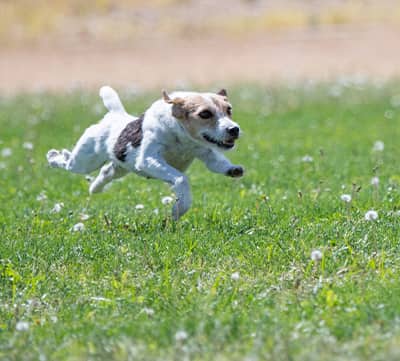What to do once your dog reaches his or her target weight
The Lucky Dog Diet is the single most effective way I have found to help overweight and obese dogs lose those unwanted pounds (or, if you have a metric dog on your paws, kilograms). Once your dog has reached his or her target weight, what should you do?
Obviously, you don’t want to return to the food that caused the problem in the first place.
Instead, my strong recommendation is to stick with the Lucky Dog Diet but to make a few small adjustments, as described below.
Don’t rush it
My suggestion is that you allow your dog to get a little thinner than you feel he or she should be. Not much, just enough to give you a bit of wriggle room, as it were.
Don’t rush to change the choice of ingredients or the volume you serve, either. Rather, you should gradually make the changes I am proposing below.
Consider different ingredients
While you have been turning your dog into a new, thinner, altogether happier hound, such delicacies as minced beef, lamb and chicken skin will have been off the menu because they all contain higher levels of fat. Once your dog has reached his or her target weight you can slowly start to introduce a wider range of ingredients, such as:
- Minced beef
- Minced lamb
- Chicken wings with the skin on
- Turkey wings with the skin on
Switch to ‘maintenance’ portions
You have been giving your dog slightly less food than he or she needs, which is why his or her weight has been dropping. Now you can start to feed very slightly more. You’ll find, after a while, that you can adjust the portion size entirely by feel and without reference to the bathroom scales. Indeed, lots of successful raw feeders simply watch their dogs carefully and adjust the quantity as they go. There is no hard-and-fast rule but for a dog over 10kg roughly 2% of their body weight in food (including edible bones) every day should be about right for a maintenance diet. In other words, a 20kg dog should be eating roughly 400g. If you have a working dog, an underweight dog or a dog that exercises a great deal then up this amount to between 2 and 5% of body weight per day.
If you have an elderly or overweight dog then reduce the amount to between 1 and 2% of bodyweight per day.
You can serve the food in as many meals as you want and at whatever time, but it should never be left down for the dog to eat when he or she feels like it. You might be interested to know that because wolves exercise so much they need about three times as much food as a typical dog. For dogs under 11kg in weight try:
1–2kg: 10% of bodyweight
3–4kg: 7% of bodyweight
5–8kg: 5% of bodyweight
9–10kg: 3% of bodyweight
11kg+: 2% of bodyweight
If you would like more detailed advice please get in touch with Honey’s. These percentages are for guidance only.
Why fasting is good for your dog’s health
From start to finish it can take a dog anything up to 20 hours to digest a full meal, a full meal being the amount it can fit in its stomach at a single sitting. This is a very long time when compared to humans, who eat much smaller meals and digest them much faster. Why is the time it takes a dog to digest important? Because a dog’s digestive system needs to rest for periods to operate at optimum efficiency. More than this, if the system doesn’t get a chance to rest it can be harmful to the dog’s health (it needs the time for its liver to transform fat to glucose). My advice is to feed your dog once a day, never to leave food down for it (eat it or lose it being the rule) and to fast your dog at least once a week.
Achieving balance
Just to remind you, dogs don’t eat completely balanced meals in the wild, but get the nutrition they need over time. You don’t, therefore, have to worry too much about balancing each meal you feed. Rather, you should be thinking about the balance over a week or even a month.
What to say to your butcher
It is definitely worth finding a good butcher as it will save you a great deal of time and money. Also, if you live anywhere near a slaughterhouse then see if they can supply you. Either way, it is much, much easier if you have plenty of freezer space. When searching for a butcher, explain what you are doing and ask for:
- scraps
- mince (this should be ‘visually lean’)
- inexpensive cuts
- offal (heart, kidneys and liver)
- raw, meaty bones
- chicken, turkey, duck, pheasant and other carcasses.
With regard to the scraps and the mince, it is fine for it to have some fat in it, but it shouldn’t be too fatty (more than 15% fat would be a problem). So far as inexpensive cuts are concerned, every butcher has his own ideas what these might be. Take ‘skirt’, which is the diaphragm under the ribs. Some butchers sell this for next to nothing; others know that there is good, lean meat to be had there and charge quite a bit for it. An efficient butcher will find you inexpensive ways to feed your dog.
Some people feel it is important that the meat they buy for their dogs is suitable for human consumption. Others don’t. The truth is that the dogs are unlikely to mind if it is a bit smelly and you shouldn’t be too obsessed with the ‘best before’ date.
Vicky Marshall
Author of the Lucky Dog Weight Loss Plan
For more information and advice on any aspect of canine health and nutrition please contact Honey’s – we’ll be happy to help even if you never, ever plan to become a customer.
Web: www.honeysrealdogfood.com
Email: info@honeysrealdogfood.com
Telephone: 01672 620 260







